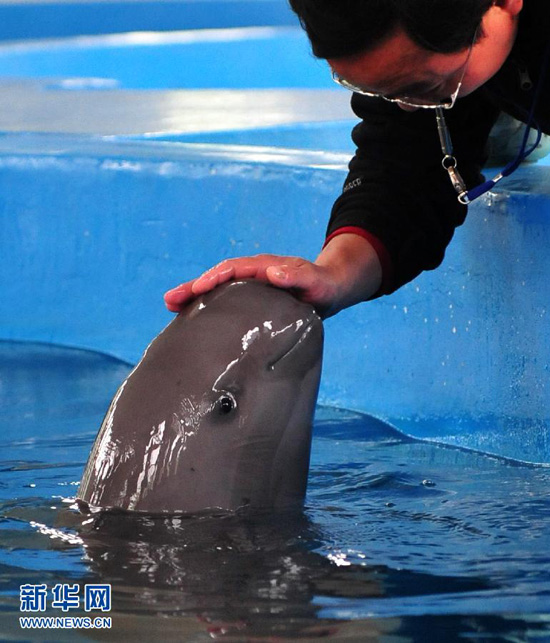Will the porpoise go the dolphin way?
- By Peter Beaudoin
 0 Comment(s)
0 Comment(s) Print
Print E-mail China Daily, April 19, 2013
E-mail China Daily, April 19, 2013
|
 |
|
A finless porpoise and its keeper in Wuhan |
A series of recent water quality and food safety issues have raised public concern. The World Wide Fund for Nature has delved into the vulnerability of the long-term health of China's rivers and wide-ranging variety of species, which depend on clean and abundant freshwater sources for their survival.
The Ministry of Agriculture recently announced that only 1,000 finless porpoises were left in the Yangtze River, its tributaries and adjoining lakes. The endangered species has declined at a shocking rate of 13.7 percent a year in recent times. At this pace, the best scientific estimates say the Yangtze finless porpoise could become extinct in 10 to 15 years.
The porpoise has thrived in the main stream of the Yangtze River for about 300,000 years and is the only surviving freshwater subspecies of the narrow-ridged finless porpoise. But excessive exploitation of resources in the Yangtze River basin has pushed the mammal to the brink of extinction.
The Yangtze River basin is home to 400 million people, and the river is the engine that drives roughly 40 percent of the Chinese economy. In economics terms, the Yangtze River basin is thriving. But at what cost? Ecologically, the Yangtze is very unhealthy - if it was a human patient it would have been placed in the intensive care unit.
Close to 56 percent of China's freshwater fish catch comes from the Yangtze, but recent evidence suggests the river's declining health is having a serious impact on four species of carp that often grace the dinner tables of the nation. Alarmingly, fry from these "big four" have declined by up to 95 percent in recent years because of river-lake disconnection, pollution, illegal fishing and water infrastructure development. This means less food for not only fish and birds, but also human beings.
That the main breeding areas of the finless porpoise - Poyang and Dongting lakes - are also the main dredging grounds for sand, needed to fuel China's construction boom, has complicated matters further.
But there is a glimmer of hope. After dozens of porpoises were found dead in the Yangtze (including about 12 in Donting Lake) in the spring of 2012, the Hunan provincial government passed a regulation to protect the species. The regulation, for the first time, links assessment of local officials' annual performance with the safety of species.
The challenge is daunting because the Dongting Lake has only a small number of the porpoises.Scientists estimate that if the species' number drops below 200 in the Yangtze, it will be unable to survive.
One solution is ex-situ (off-site) conservation, in which a number of animals are isolated from the rest of the species and shifted to a safer habitat in which they can thrive. The Tian-e-zhou Oxbow Semi-natural Reserve near Shishou city in Hubei province was established as the first ex-situ reserve for dolphins more than two decades ago. Different from traditional ex-situ conservation, which involves transporting of species to an area that is not its natural environs, the habitat in Tian-e-zhou reserve is nearly the same as the Yangtze River, because it was once part of the river.
Though the Tian-e-zhou reserve was created for the Yangtze River dolphin (or baiji), five finless porpoises were moved there later. And with the support of the WWF and the Institute of Hydrobiology of the Chinese Academy of Sciences, their number has increased to more than 40. The Tian-e-zhou reserve, where two to five calves have been born each year, is proof that given the right conditions, the finless porpoise can survive.
For the porpoise number to grow, the WWF recommends that the government:
* Take urgent measures for conservation of the species in the main stream of the Yangtze, as well as Poyang and Dongting lakes, which is an extremely challenging but unavoidable task;
* Establish more ex-situ sites, especially cut off from the main stream of the Yangtze, which can serve as a protected habitat for the survival of a viable number of the marine mammals;
* Take immediate steps to identify the finless porpoise as a Level 1 species in order to ensure that the focus of conservation is on long-term viability of the porpoise.
The baiji was declared functionally extinct six years ago. It looks like its close relative, the finless porpoise, is heading in the same direction. To prevent that from happening, immediate action has to be taken. The identification of another ex-situ conservation site by the Hubei provincial government is a step in the right direction, though reviewing and preparing the site in Jianli county will take up to two years.
Since scientists have affirmed that the finless porpoise won't survive in the main stream of the Yangtze without support, collective efforts are needed to prevent another species from becoming extinct.
The author is chief executive officer of World Wide Fund For Nature-China.





